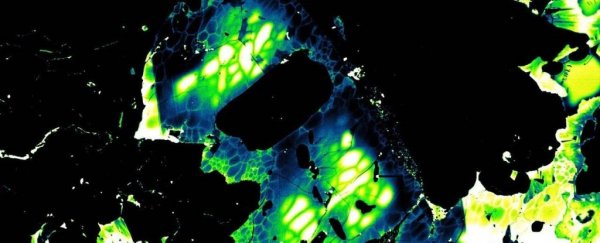A meteor that exploded in the sky over Chelyabinsk, Russia in 2013 could have also been somehow involved in the giant impact that formed the Moon.
This tantalizing finding comes thanks to a new way of dating collisions between rocks in space, based on microscopic analysis of minerals within meteorites. Although further investigation is warranted, the technique could give us a new probe for understanding the violent early history of the Solar System, and how it evolved into its current shape.
"Meteorite impact ages are often controversial," said geoscientist Craig Walton of the University of Cambridge in the UK.
"Our work shows that we need to draw on multiple lines of evidence to be more certain about impact histories – almost like investigating an ancient crime scene."
Asteroids and meteorites are often studied as time capsules of the formation of the Solar System, around 4.5 billion years ago. That's because, when the Solar System was forming from a disk of dust and gas whirling around the newborn Sun, the planets formed through repeated collisions of smaller rocks.
Here on Earth, as well as on other planets, that history is exceedingly difficult to trace, since geological and weather processes have overwritten it. Even large surface impacts can be hidden.
Asteroids, on the other hand, are inert, and can float around in the void of space remaining more or less unchanged, until they get sucked into Earth's gravity well and fall down to the planet as a meteorite.
We do have some means of dating ancient collisions in the minerals found in meteorites. One of these is through uranium-lead dating in zircon crystals. When it is forming, zircon incorporates uranium, but strongly rejects lead. Therefore, any lead that is found in zircon has to be the product of the radioactive decay of uranium. We know how long uranium takes to decay, therefore we can infer the age of the zircon from the lead component.
In addition, an impact can even partially or entirely 'reset' the radioisotope mineral ages. With this tool in hand, scientists had previously found that the Chelyabinsk meteorite had undergone two impact events, one around 4.5 billion years ago, and the other around 50 million years ago.
Walton and his colleagues wanted to corroborate these dates by studying the way phosphate minerals in the meteorite had shattered over successive impacts.
"The phosphates in most primitive meteorites are fantastic targets for dating the shock events experienced by the meteorites on their parent bodies," said geophysicist Sen Hu of the Chinese Academy of Sciences in China.
Taking new uranium-lead dating for a point of comparison, the researchers studied the microscopic details of how the phosphate minerals had shattered, and the effect of impact-induced heating on the crystal structure.
They found that the earlier impact, occurring 4.5 billion years ago, shattered phosphate minerals into small pieces, and subjected them to high temperatures. The later impact seemed lesser, with lower pressures and temperatures. The team's results suggest that this impact occurred less than 50 million years ago.
It was also, they believe, likely the impact that broke the meteorite off its larger parent body, and sent it on a collision course with Earth.
The findings about the earlier impact support previous evidence that there was a lot of high-energy rock-smashing in space between 4.48 to 4.44 billion years ago. This time frame is important because it could coincide with two separate major formative periods in Solar System history: the migration of the giant planets, or the ancient collision that scientists believe broke off a chunk of baby Earth to form the Moon.
"The fact that all of these asteroids record intense melting at this time might indicate Solar System reorganization, either resulting from the Earth-Moon formation or perhaps the orbital movements of giant planets," Walton said.
Planetary migration involves the giant planets ( Jupiter, Saturn, Neptune, and Uranus) forming farther from the Sun than their current positions, and moving closer in over time. This motion would have caused a lot of gravitational perturbation in the earlier Solar System, resulting in a large number of collisions between rocks.
In the Moon formation scenario, a Mars-sized body is thought to have smashed into Earth around 4.5 billion years ago (give or take), ejecting a bunch of material into space, which coalesced to form the Moon. This spray of ejecta would also have resulted in an uptick in collisions.
The next step in the research, the team said, is to revisit the timing of the Moon's formation, which should shed more light on this fascinating mystery.
The research has been published in Communications Earth & Environment.
